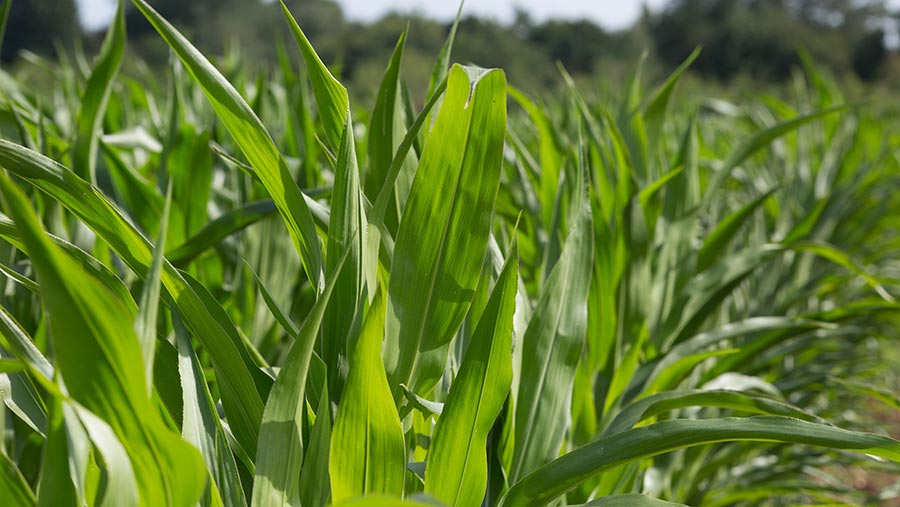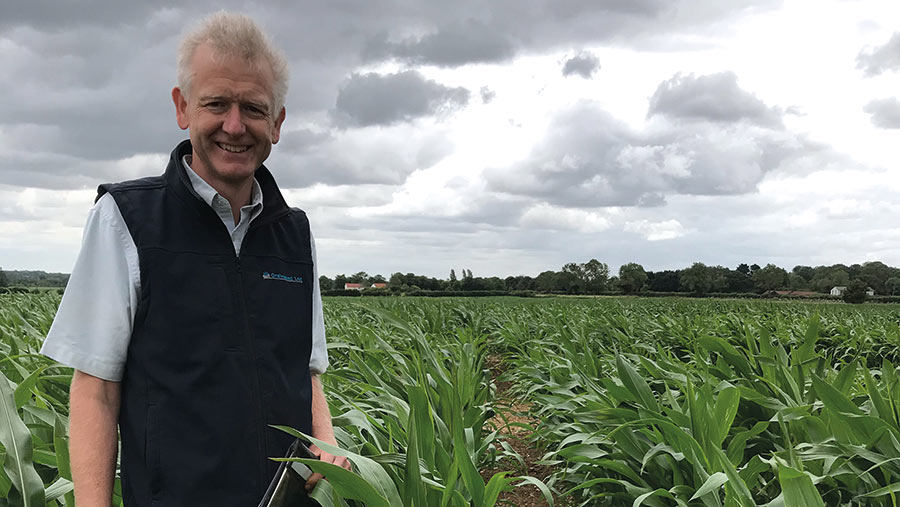Advice on dealing with this year’s variable maize crop
 © Tim Scrivener
© Tim Scrivener Maize growers are facing one of the most variable cropping years on record after a prolonged dry spring was followed by cooler, wetter weather.
The Maize Growers Association reports the variation in growth stages means some crops have already grown beyond 1.5m tall, while others are struggling to reach knee height.
Maize supplier Grainseed’s technical director, Neil Groom, says certain fields have produced some of the best maize crops he has ever seen.
See also: Maize grown under film more than 1.8m tall already

Neil Groom. © Flora Archer
Mr Groom says crops that were drilled earlier, during ideal fieldwork conditions and into soil with enough moisture, saw seeds germinate quickly and uniformly.
As well as good germination, the moisture and higher temperatures mobilised soil nutrients, particularly where fields had a history of muck and slurry applications.
These fields are three to four weeks ahead, with plants approaching 2m tall and coming into tassel.
This could be as soon as August and certainly by the first week of September.
Low growth
Conversely, the same dry weather had caused growth checks in certain field conditions.
On lighter soils, with poor levels of organic matter – perhaps where the field has been switched from oilseed rape – it was June before seed germinated, Mr Groom explains.
Only when the first rain arrived did the crop start to emerge.
In these fields, crops are still at leaf stage four to six. That means they are only just about hitting the “knee-high by 4 July” mark that acts as a minimum level for a viable crop.
Uneven growth
But arguably the most difficult situation faced by growers, this year, is in fields where the crop has grown unevenly.
Differing soil, such as types, moisture levels and temperatures, across individual fields has produced crops with a wide variation of emergence and growth.
“I have seen the whole spectrum of growth within one field,” Mr Groom reports.
This poses a dilemma at harvest if parts of the field mature early and other parts are later than average.
The only practical solution is to work out where the majority maturation lies and harvest according to that, he suggests.
Advice for crops
- Where crops are well grown, watch crop maturation carefully and be prepared to harvest early.
- Review the nutrient levels applied to crops still at leaf stage four to five. If bagged fertiliser has not been applied, it may be worth freshening up these crops with some additional nutrients
- However, caution is required. Once crops have gone beyond the leaf stage four to six, fertiliser granules can get lodged in leaf axils leading to nitrogen scorching. Instead of using prill fertiliser, use a foliar spray.
- If crops are looking yellow in colour and are slow to establish, carry out tissue tests. It may reveal boron and manganese are short as well as nitrogen.
- Weeds: After the leaf eight stage, most herbicide manufacturers do not recommend spraying because herbicide contact with the larger leaf area can cause scorching. Where weeds have kept pace with slow-growing maize this year, it may be necessary to use a spray even beyond the leaf eight stage. To reduce the effect of scorching, which is caused by a combination of the product itself and bright sunlight, applications should be carried out after 8pm in the evening.
- Eyespot: This can become a problem in mid-July. If conditions remain cooler and wetter, particularly in the West, growers should treat crops to prevent the fungal disease, causing early senescence before the plant converts leaf sugars into starch. A high-clearance sprayer must be used to ensure the crop is not damaged.
